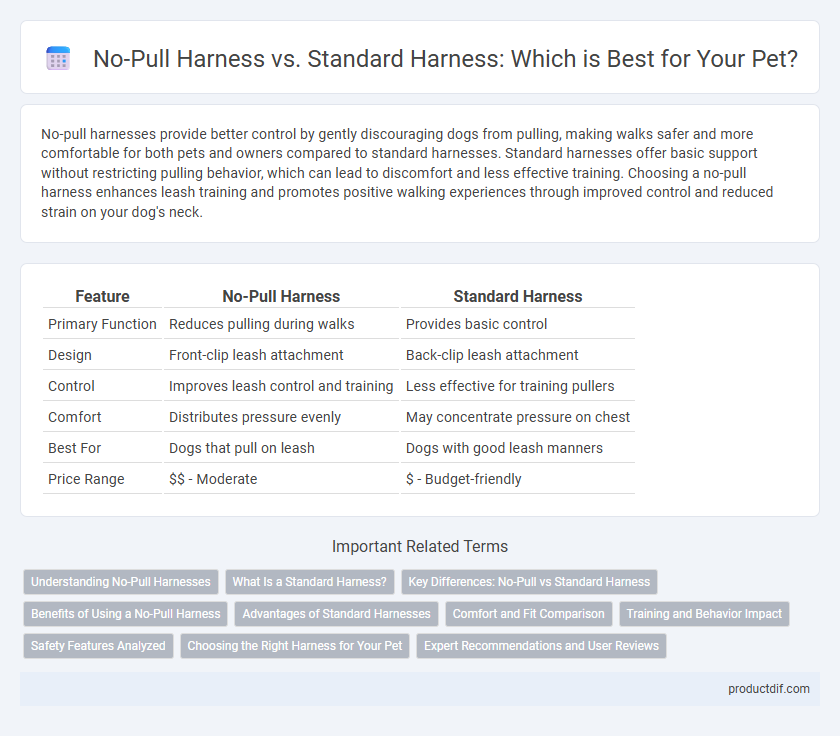No-pull harnesses provide better control by gently discouraging dogs from pulling, making walks safer and more comfortable for both pets and owners compared to standard harnesses. Standard harnesses offer basic support without restricting pulling behavior, which can lead to discomfort and less effective training. Choosing a no-pull harness enhances leash training and promotes positive walking experiences through improved control and reduced strain on your dog's neck.
Table of Comparison
| Feature | No-Pull Harness | Standard Harness |
|---|---|---|
| Primary Function | Reduces pulling during walks | Provides basic control |
| Design | Front-clip leash attachment | Back-clip leash attachment |
| Control | Improves leash control and training | Less effective for training pullers |
| Comfort | Distributes pressure evenly | May concentrate pressure on chest |
| Best For | Dogs that pull on leash | Dogs with good leash manners |
| Price Range | $$ - Moderate | $ - Budget-friendly |
Understanding No-Pull Harnesses
No-pull harnesses are designed to reduce a dog's pulling behavior by distributing pressure evenly across the chest and shoulders, preventing choking or discomfort. Unlike standard harnesses, which primarily provide control without correcting pulling, no-pull harnesses use front-clip or dual-clip designs to redirect a dog's forward motion. This effective control mechanism enhances training outcomes and improves walking safety for both pets and owners.
What Is a Standard Harness?
A standard harness typically features a simple design with a single attachment point on the back, allowing for basic control and comfort during walks. It distributes pressure evenly across a dog's chest and shoulders, minimizing strain compared to a collar. Commonly made from durable materials like nylon or leather, it suits everyday use but lacks specialized mechanisms to prevent pulling behavior.
Key Differences: No-Pull vs Standard Harness
No-pull harnesses feature front-clip designs that reduce pulling by redirecting a dog's forward momentum, promoting better leash control and less strain on the pet's neck. Standard harnesses typically have back-clip attachments that allow more freedom of movement but can encourage pulling behavior due to less restraint. The key difference lies in control and training effectiveness, with no-pull harnesses better suited for managing active, strong pullers during walks.
Benefits of Using a No-Pull Harness
A No-Pull Harness enhances control and reduces strain on both pets and owners by discouraging pulling behavior during walks. Designed with front-clip attachments, it redirects a dog's momentum toward the owner, promoting safer and more enjoyable outdoor experiences. Compared to standard harnesses, it offers superior comfort and improved training outcomes for active or reactive dogs.
Advantages of Standard Harnesses
Standard harnesses provide consistent comfort and secure control, reducing pressure on a pet's neck and preventing choking risks common with collars. Their simpler design makes them easier to put on and adjust, offering versatility for everyday walks and various dog sizes. Compared to no-pull harnesses, standard harnesses generally promote natural movement without adding restrictive tension.
Comfort and Fit Comparison
No-pull harnesses distribute pressure evenly across a dog's chest and shoulders, reducing strain and preventing choking, which enhances comfort during walks. Standard harnesses may exert more localized pressure, potentially causing discomfort or restricting movement if not properly fitted. Proper fit in no-pull harnesses is crucial for maximizing comfort, utilizing adjustable straps and padding to accommodate various dog breeds and sizes.
Training and Behavior Impact
No-pull harnesses significantly reduce pulling behavior by distributing pressure evenly and providing better control, making training sessions more effective and less stressful for both pets and owners. Standard harnesses often encourage pulling because they lack the design features that deter leash tension, potentially reinforcing bad habits during walks. Incorporating a no-pull harness in training promotes better leash manners and enhances overall behavior management.
Safety Features Analyzed
No-pull harnesses are designed with front-clip attachments that reduce pulling forces, enhancing control and preventing neck strain or injury in dogs. Standard harnesses typically have back-clip designs that may allow pets to pull harder, increasing the risk of choking or neck trauma. Safety analyses show no-pull harnesses distribute pressure evenly across the chest, minimizing potential harm and improving both pet and owner safety during walks.
Choosing the Right Harness for Your Pet
Choosing the right harness for your pet depends on their behavior and comfort needs; no-pull harnesses are ideal for dogs that tend to tug, as they distribute pressure evenly and reduce strain on the neck. Standard harnesses offer simplicity and ease of use, making them suitable for well-trained pets or short walks. Evaluating your pet's size, strength, and walking habits ensures the harness you select promotes safety and control during outings.
Expert Recommendations and User Reviews
Experts recommend No-Pull Harnesses for training dogs prone to pulling, highlighting better control and reduced strain on pets. User reviews frequently emphasize increased comfort and improved walking experience compared to Standard Harnesses, which may restrict movement and encourage pulling. Durable materials and adjustable features in No-Pull Harnesses contribute to their overall higher satisfaction among pet owners.
No-Pull Harness vs Standard Harness Infographic

 productdif.com
productdif.com